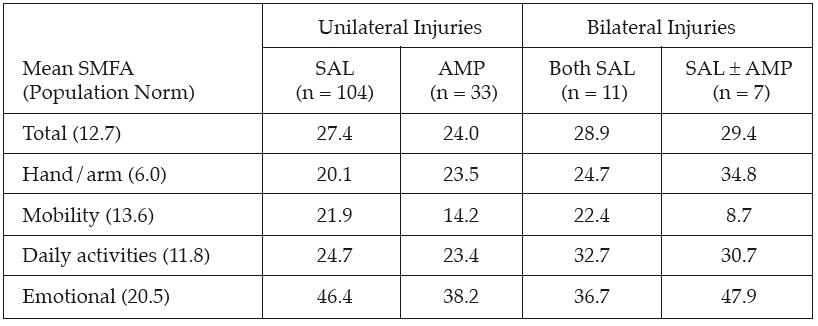
OTA 2012 Posters
Scientific Poster #93 Upper Extremity OTA-2012
Functional Outcomes Following Major Upper Limb Trauma in the Military
The METALS Study Group;
Brown University Department of Orthopaedic Surgery, Providence, Rhode Island, USA
Purpose: This study was undertaken to examine outcomes following major upper limb trauma resulting from high-energy blast/ordnance-related mechanisms and to compare outcomes for those undergoing amputation or limb salvage. We hypothesized that outcomes would be better for limb salvage patients.
Methods: This is a retrospective cohort study of 155 US service members who sustained a major upper limb injury while serving in Afghanistan or Iraq. Major limb trauma was defined as resulting in a major amputation (at or proximal to the radiocarpal joint) or requiring reconstruction surgery and either revascularization, bone grafting/bone transport, local/free flap coverage, repair of major nerve injury, or complete compartment injury/compartment syndrome. Participants were interviewed (mean 37.3 months postinjury) and medical records abstracted. The Short Musculoskeletal Function Assessment (SMFA) was used to measure overall function. Additional batteries were used to assess depressive symptoms (Center for Epidemiological Studies Depression Scale), posttraumatic stress (Military Version of the PTSD [Posttraumatic Stress Disorder] Checklist), chronic pain (Chronic Pain Grade Scale), and participation in vigorous sports (Paffenbarger Activity Scale). Differences in outcomes were compared using regression analysis adjusting for age, time to interview, military rank, lower limb injury, social support, and combat experiences (Combat Experiences Questionnaire).
Results: Overall, participants report moderate to high levels of disability. 40% have depressive symptoms and 19% screen positive for posttraumatic stress. 18% report pain that interferes with activity and 36% were not working, on active duty, or going to school at follow-up. Mean SMFA scores are shown for 4 groups defined by unilateral versus bilateral major upper limb injury and whether the injury resulted in amputation (AMP) or limb salvage (SAL). Approximately one-third of participants also sustained a major injury to their lower limbs. Removing these individuals from the analysis resulted in similar outcomes (except for SMFA mobility). After adjusting for covariates, there were no significant differences in SMFA or percent with symptoms of depression or PTSD when patients with or without amputation are compared. Significant correlates of outcome included age, time since injury, military rank, intensity of combat experiences, and social support.
Conclusion: Major upper limb trauma sustained in the military results in significant long-term disability. These outcomes are similar for those undergoing amputation or limb salvage. There is a need for ongoing improvements in treatment and support to more fully return these casualties with severe upper extremity injury to optimal function.

• The FDA has not cleared this drug and/or medical device for the use described in this presentation (i.e., the drug or medical device is being discussed for an “off label” use). ◆FDA information not available at time of printing. Δ OTA Grant.